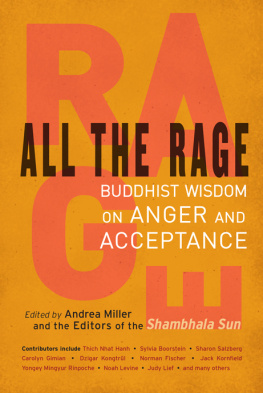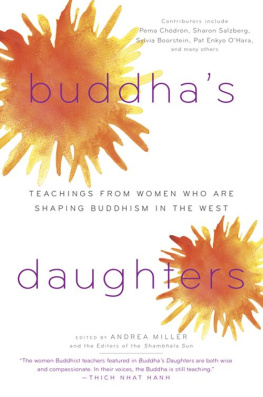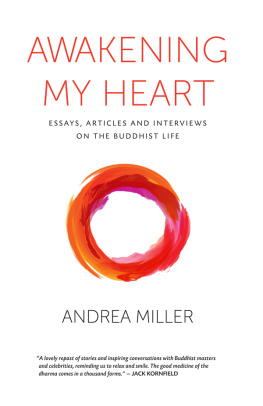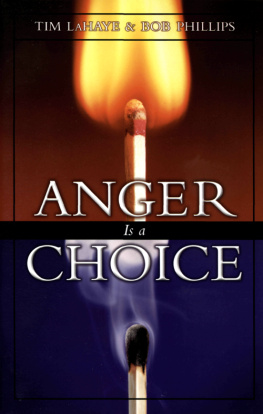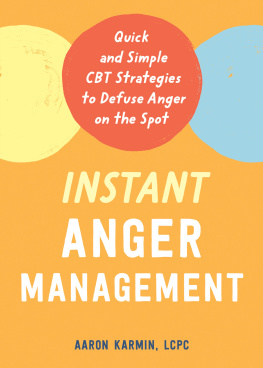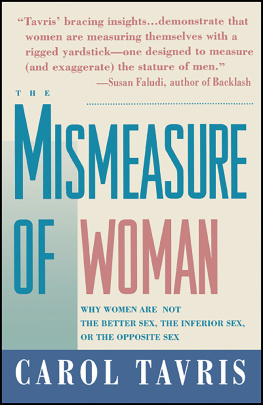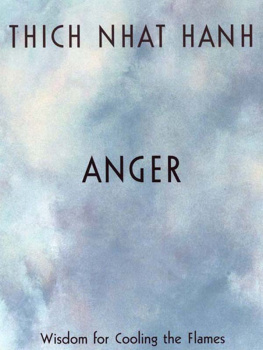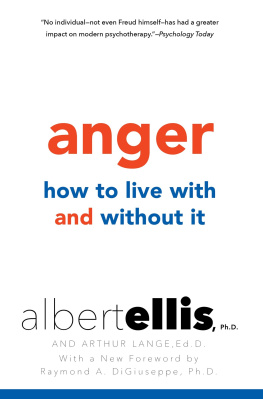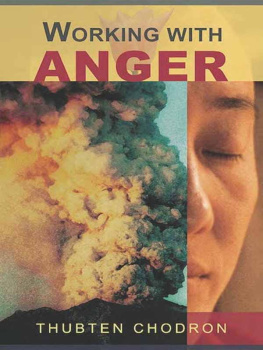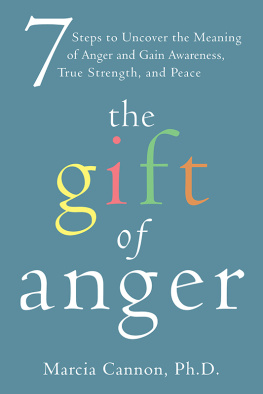ABOUT THE BOOK
Anger. For all of us, its a familiar feelingjaw clenching, face flushing, hands shaking. We feel it for rational and irrational reasons, on a personal and on a global level. If we know how to handle our anger skillfully, it is an effective tool for helping us recognize that a situation needs to change and for providing the energy to create that change. Yet more often anger is destructiveand in its grip we hurt ourselves and those around us.
In recent years scientists have discovered that mindfulness practice can reduce stress, improve mood, and enhance our sense of well-being. It also offers us a way of dealing with strong emotions, like anger. This anthology offers a Buddhist perspective on how we can better work with anger and ultimately transform it into compassion, with insight and practices from a variety of contributors, including Thich Nhat Hanh, Sharon Salzberg, Sylvia Boorstein, Carolyn Gimian, Tara Bennett-Goleman, Pat Enkyo OHara, Jules Shuzen Harris, Christina Feldman, Mark Epstein, Ezra Bayda, Judith Toy, Noah Levine, Judy Lief, Norman Fischer, Jack Kornfield, Stan Goldberg, Yongey Mingyur Rinpoche, Dzigar Kongtrl, and many others.
ANDREA MILLER is an editor and staff writer for Shambhala Sun magazine.
Sign up to receive news and special offers from Shambhala Publications.

Or visit us online to sign up at shambhala.com/eshambhala.
All the Rage
Buddhist Wisdom on Angerand Acceptance
EDITED BY Andrea Miller
and the editors of the Shambhala Sun

Shambhala
Boston & London
2014
Shambhala Publications, Inc.
Horticultural Hall
300 Massachusetts Avenue
Boston, Massachusetts 02115
www.shambhala.com
2014 by Andrea Miller and the editors of the Shambhala Sun
Cover design by Jim Zaccaria
All rights reserved. No part of this book may be reproduced in any form or by any means, electronic or mechanical, including photocopying, recording, or by any information storage and retrieval system, without permission in writing from the publisher.
Library of Congress Cataloging-in-Publication Data
All the rage: Buddhist wisdom on anger and acceptance / Edited by Andrea Miller and the editors of the Shambhala Sun.First edition.
pages cm
eISBN 978-0-8348-2988-6
ISBN 978-1-61180-171-2 (alk. paper)
1. AngerReligious aspectsBuddhism. 2. CompassionReligious aspectsBuddhism. 3. Religious lifeBuddhism. I. Miller, Andrea (Shambhala Sun editor)
BQ4430.A53A55 2014
294.35698dc23
2014002343
Contents
PART ONE
Understanding Anger
Thich Nhat Hanh
Tara Bennett-Goleman
Toni Bernhard
Carolyn Gimian
Dzigar Kongtrl
Pat Enkyo OHara
PART TWO
Practicing with Anger
Jules Shuzen Harris
Karen Connelly
Norman Fischer
Sister Chan Khong
Shozan Jack Haubner
Joan Sutherland
PART THREE
Going Beyond Blame
Sylvia Boorstein
Mitchell Ratner
B. Alan Wallace
Christina Feldman
Mark Epstein
Rachel Neumann
PART FOUR
Finding Forgiveness
Karen Maezen Miller
Ezra Bayda
Judith Toy
Jack Kornfield
Stan Goldberg
Elaine Pierce
PART FIVE
Opening to Compassion
Sharon Salzberg
Yongey Mingyur Rinpoche
Brian Haycock
Joanna Macy
Noah Levine
Judy Lief
You would never peg me as someone whod get in a fistfight, and youd be right. But all the same, there was this one time more than a decade ago.
Urgently needing a place to live, I hastily signed the lease to a drafty apartment with sloping floors and cracks in the walls. I asked the landlord if I could move in on the last day of the month, and he said, No problem. But twenty-four hours before the scheduled move, the apartments current tenants apparently had a change of plans and the landlord asked if I could postpone moving by a day. At this point, though, I couldnt; Id already enlisted movers.
The landlord phoned again. Okay, he said, the tenants who are in there now will empty a bedroom for you. You can pile your things into that room. Then the next day, theyll get their stuff out and you can begin living in the apartment. Though not ideal, this was workable.
At the appointed time, I arrived with a load of furniture. The promised bedroom, however, wasnt ready, and the tenants were unapologetic, particularly the woman. Within a hot minute, she and I were raising our voices. All of my irritation with this couple for changing the date, all of my frustration with packing and hefting and organizingit was all channeled into a heart-thumping electric rage, and I saw the same feeling reflected in the womans red face. To make matters worse, we were jammed into a tiny kitchen, a space too small for this anger. I sized the woman up. She was my age and small like me. I could take her.
Then suddenly, just before thought became action, my friend came in, breaking the moment. Now the room seemed to spin. Id gone to a rough high school where Id often heard the chant Fight, fight, fight.... Yet Id avoided those altercations. Id always seen myself as too mature to get in a fistfighttoo sophisticated, too peaceable. Later, when my friend and I were alone in the kitchen, I said, still dismayed, That almost got physical. Yeah, she answered. I could hear it.
Since that day, Im more sympathetic to people whose anger leads to blows; I know that I have a shard of that behavior in me, too. I also more clearly see the need for understanding where anger comes from, how it manifests, and how Ihow wecan work with it most skillfully. This anthology explores these questions from a Buddhist perspective.
The first section, Understanding Anger, looks at the origin of this emotion and how it impacts our relationships and sense of well-being. Thich Nhat Hanh begins by explaining that in our subconscious mind, we all have negative seeds such as anger, yet we also have positive seeds such as joy, understanding, and compassion. Whenever one of our seeds manifests in our conscious mind, that seed becomes stronger and more likely to manifest again. We cannot eradicate any particular seed, says Thich Nhat Hanh, but we can choose which seeds to water.
Part 2, Practicing with Anger, focuses on concrete methods. The teachings in this section include Sister Chan Khongs Beginning Anew, which emphasizes communication. We can learn to listen openly to the grievances others have against us, she says, and likewise we can learn to express our hurt or angry feelings without lashing out. In this way we find solutions to problems rather than add fuel to the fire. Practicing with Anger also features lively first-person pieces that provide examples of Buddhist practitioners grappling with anger in daily life. In her interaction with her young son, Karen Connelly sees that she gets back whatever emotion she herself expresses. Through his misadventures with irksome members of his sangha, Shozan Jack Haubner discovers that the people in our life dont get in the way of our spiritual practice; these people are our spiritual practice.
Sylvia Boorstein gets to the heart of the matter: The results of ignorancegreed, hatred, and delusionare the real causes of conflict, not particular people, political parties, or countries. So while there may be people who we could nameand blameas culprits, we would all be better served by recognizing ignorance as the true enemy. Grounded in this understanding, we would then be inspired to right any wrongdoing in a way that is at once firm and loving.
Next page
